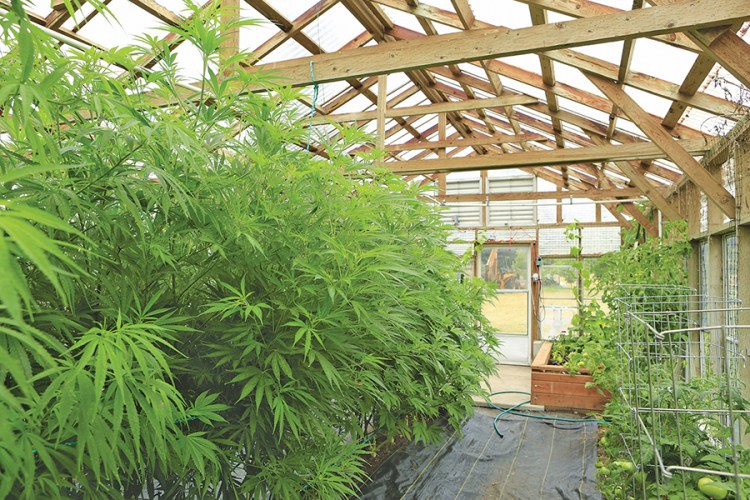If you can just go to the dispensary on the corner and pick up whatever strain you want, why bother growing cannabis? Well, my favorite story growing up was ‘The Little Red Hen.’ The moral is that the effort it takes to grow something is as important as the results.
 Growing at home can be a fun, educational process (and it’s your right to do so in Maine). If the harvest is not for you, it could be for someone close to you who may be in need. Here are a few basic tips to inspire the curious:
Growing at home can be a fun, educational process (and it’s your right to do so in Maine). If the harvest is not for you, it could be for someone close to you who may be in need. Here are a few basic tips to inspire the curious:
Get started
A successful home grow starts with a loving home. Like pets, plants cannot feed themselves and are dependent on your care. You must have time to check on your plants at least once a day.
As a warm season, flower-producing annual, cannabis plants grown indoors have the same needs as those grown outdoors. The goal for a successful indoor grow is to try to mimic these six major conditions: fresh air, quality soil, strong light, clean water, temperature control and generous nutrients.
Picking your plant babies
Seeds and seedlings have unique genetics. A new plant is only as strong as its parent—so start with quality. If you are starting a grow outside of spring or summer, you might want a heating mat and humidity dome for fragile seedlings.
Do you want to grow sativa or indica strains? Sativa plants are often larger, so you will need more space. If you are limited in space and skill, consider an autoflower or dwarf variety, which will grow and flower with time regardless of the light-to-dark ratios it endures. They are more delicate, but can grow in tight spaces and be ready for harvest in 10 to 14 weeks.
A feminized seed will only grow flowers. A non-feminized seed is likely to be male. Male plants make only seeds and no flowers. Hermaphroditic seeds grow plants that produce seeds and buds. That sounds great—free seeds! But they open and pollinate the room, turning plants that would have otherwise been female into other seeded flowers.
Even with a great set of seeds, only expect 75-85% germination rate. Starting with seedlings will give you a leg up.
Air and Soil
Proper air flow in your grow space will clean the plant, strengthen its stem and branch system and prevent mold and rot. A big investment for indoor growing is an intake and exhaust system.
Airy, nutrient rich soil is also key, as well as increasing the size of the growing container as your plant grows. You could also use a soil substitute like coco coir with misting or “fogponics” systems. Another investment to make down the line is a hydroponic system.
Lighting
Light is your plant’s life. If you have a natural light-filled grow room, make it reflective—add a coat of bright white paint or line the walls with Mylar film.
If you are investing in a lighting system, do your research before spending a ton of money. Your plants will need two kinds of lighting during their lives: Vegetative light and flowering light. Vegetative light is a bright, blue-white light, which mimics early spring sunlight. Flowering light is a warmer amber color, mimicking harvest time and encouraging more buds.
Planted seedlings can withstand up to 24 hours of light for the first few weeks. Afterward, the plant will need a “recovery sleep” in darkness at least 6 to 8 hours per day. If you need to water or trim the plants or clean during sleep hours, use a green marker to color a lightbulb on a stationary lamp.
Water
Yellow spots, burned ends, dying branches and root rot are some visible symptoms of a plant being under-fed or overloaded. A common mistake to make with all types of indoor plants is overwatering. But just like other plants, the best way to know if your cannabis plant needs water is to stick a finger down a couple inches into the soil. If it’s dry, it’s time to water.
Know your water quality. Do not give a plant water right out of the faucet. Buy a filter or fill your watering can and let it sit for a day or two. Go the next step and get testing strips to check the water’s ph levels before every feeding.
Nutrition
Seeds and seedlings do not need nutrients, but once a few sets of leaves have appeared, introduce a fertilizer every other watering. I like to add calcium and magnesium supplements once the plant starts to flower.
Additional Reading and Resources
| Gardening Indoors with Soil & Hydroponics by George F. Van Patten (Van Patten)
| Marijuana Horticulture by Jorge Cervantes (Van Patten)
| ILoveGrowingMarijuana.com by Robert Bergman
By Tiffany Dean
Comments are not available on this story.
Send questions/comments to the editors.


